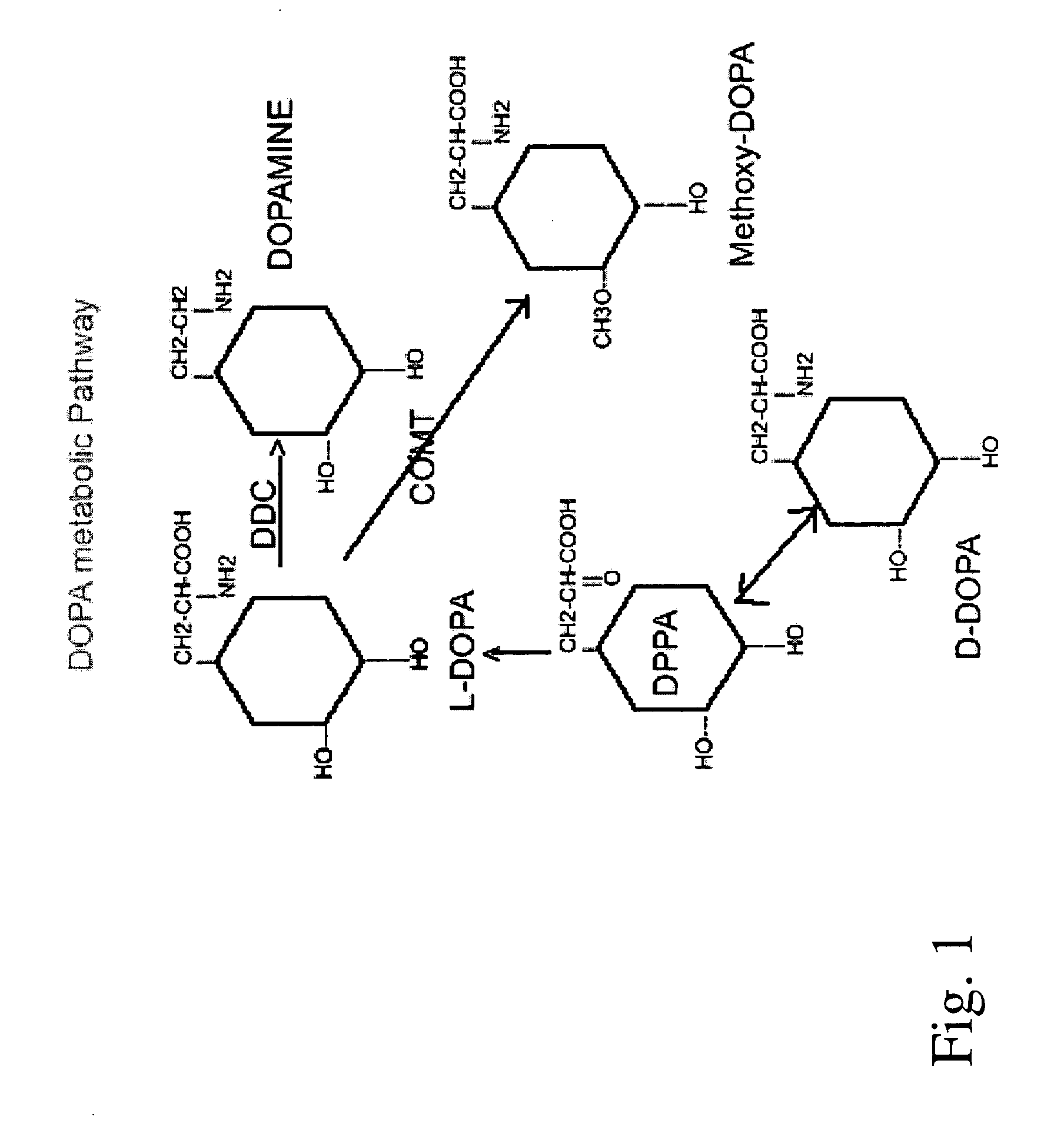Compositions and methods of using D-DOPA to treat Parkinson's disease
a technology of d-dopa and parkinson's disease, which is applied in the field of compositions and methods of using d-dopa to treat parkinson's disease, can solve the problems of ineffective therapy, small percentage of orally administered l-dopa actually crossing the blood brain barrier, and almost always associated with untoward side effects, so as to increase the bioavailability of dopamin
- Summary
- Abstract
- Description
- Claims
- Application Information
AI Technical Summary
Benefits of technology
Problems solved by technology
Method used
Image
Examples
example 1
[0051] The present example illustrates the efficacy of the administration of D-DOPA of L-DOPA in vivo. In order to show the effectiveness of D-DOPA for increasing striatal dopamine content, male Sprague-Dawley Rats (Zivic-Miller, Allison Park, Pa.) weighing 300 to 400 grams were used. At least four weeks prior to the experiments, unilateral Substantia Nigra lesions were produced with intranigral administration of 6-hydroxydopamine according to the procedures set forth in Ungerstedt, Acta Physiol. Scand. (Suppl.) 367, 69 (1971).
[0052] The extent of unilateral Substantia Nigra lesions was tested by measuring apomorphine simulated rotation according to the procedures described in Understedt, supra, 1971; Freed et al. Ann. Neurol. 8, 510 (1980).
[0053] Either D- or L-DOPA was intragastrically administered to the rats in combination with carbidopa at doses of 50 mg / kg body weight of D-DOPA or L-DOPA and 5 mg / kg body weight of carbidopa, suspended in sterile water, to provide a pharmaceu...
example 2
[0055] The present example illustrates the possible involvement of DHPPA in the formation of dopamine from D-DOPA. Since L-amino acid decarboxylase is stereospecific, direct decarboxylation by the enzyme does not appear to account for the substantial formation of dopamine from D-DOPA. In an attempt to examine an alternate pathway, four groups of Sprague-Dawley rats weighing 120-150 grams with cannulae permanently implanted into their lateral ventricles, according to the procedure described in Robinson et al., Physiol. Behav. 4, 123-124, (1969), were used. One group received 10 μl. of saline into the ventricles. The second, third and fourth groups received, intraventricularly, 200.μ.g of L-DOPA, D-DOPA and 3,4-dihydroxyphenylpyruvic acid (DHPPA) in 10 μl of saline, respectively. The rats were sacrificed two hours after treatment and their striata removed and analyzed. Striatal concentrations of dopamine, DOPAC and HVA were measured by massfragmentography according to the procedure se...
example 3
[0058] The present example illustrates the effects of carbidopa on the urinary excretion of dopamine after the administration of D- and L-DOPA alone, (50 mg / kg). Carbidopa reduced the excretion of dopamine following D-DOPA to a far greater degree than when carbidopa was co-administered with L-DOPA as set forth in Karoum et al., Brain Research, 1988. These results suggest that the pathways responsible for the formation of dopamine from D-DOPA in the periphery are more sensitive to carbidopa than are the pathways that convert L-DOPA to dopamine. Hence, one might expect that in rats receiving equal doses of either stereoisomer, proportionately more D-DOPA than L-DOPA will cross into the brain when each of these amino acids is co-administered with carbidopa. The unexpected ability of D-DOPA to elevate striatal concentrations of dopamine suggests that D-DOPA offers advantages over L-DOPA in the treatment of Parkinson's disease. For example, the peripheral undesirable side effects normall...
PUM
| Property | Measurement | Unit |
|---|---|---|
| time | aaaaa | aaaaa |
| time | aaaaa | aaaaa |
| volumes | aaaaa | aaaaa |
Abstract
Description
Claims
Application Information
 Login to View More
Login to View More - R&D
- Intellectual Property
- Life Sciences
- Materials
- Tech Scout
- Unparalleled Data Quality
- Higher Quality Content
- 60% Fewer Hallucinations
Browse by: Latest US Patents, China's latest patents, Technical Efficacy Thesaurus, Application Domain, Technology Topic, Popular Technical Reports.
© 2025 PatSnap. All rights reserved.Legal|Privacy policy|Modern Slavery Act Transparency Statement|Sitemap|About US| Contact US: help@patsnap.com


